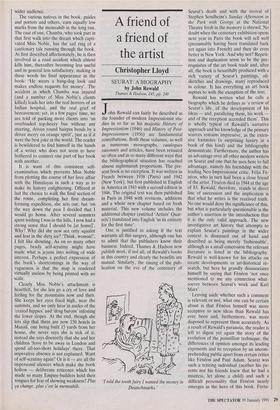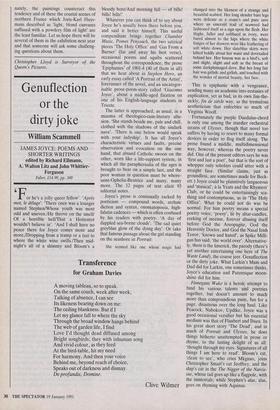A friend of a friend of the artist
Christopher Lloyd
SEURAT: A BIOGRAPHY by John Rewald
Thames & Hudson, £45, pp. 240
John Rewald can fairly be described as the founder of modern Impressionist stu- dies in so far as his majestic History of Impressionism (1946) and History of Post- impressionism (1956) are fundamental contributions. Both these volumes, as well as numerous monographs, catalogues raisonnes and articles, have been reissued so often and in so many different ways that the bibliographical situation has reached almost nightmarish proportions. The pre- sent book is no exception. It was written in French between 1938 (Paris) and 1942 (New York), but first published in English in America in 1943 with a second edition in 1946. The original text was then published in Paris in 1948 with revisions, additions and a whole new chapter based on fresh material. This new volume includes the additional chapter (entitled 'Artists' Quar- rels') translated into English 'in its entirety for the first time'.
One is justified in asking if the text warrants all this surgery, although one has to admit that the publishers know their business. Indeed, Thames & Hudson now publish most, if not all, of Rewald's books in this country and clearly the benefits are mutual. Similarly, the timing of the pub- lication on the eve of the centenary of 'I told the tooth fairy I wanted the money in Deutschmarks.' Seurat's death and with the revival of Stephen Sondheim's Sunday Afternoon in the Park with George at the National Theatre fresh in the memory is shrewd. No doubt when the centenary exhibition opens next year in Paris the book will sell well (presumably having been translated back yet again into French) and then do even better in New York. And why not? Repeti- tion and duplication seem to be the pre- requisites of the art book trade and, after all, the book is beautifully produced with a rich variety of Seurat's paintings, oil- sketches and drawings, many reproduced in colour. It has everything an art book aspires to with the exception of the text.
Rewald has written what he calls a biography which he defines as 'a review of Seurat's life, of the development of his ideas — and, paralleling them, his work and of the reception accorded them'. This is wholly typical of Rewald's narrative approach and his knowledge of the primary sources remains impressive, as the exten- sive footnotes (a surprising luxury in a book of this kind) and the bibliography demonstrate. Furthermore, the author has an advantage over all other modern writers on Seurat and one that he uses here to full advantage, namely his friendship with the leading Neo-Impressionist critic, Felix Fe- neon, who in turn had been a close friend of the artist. Feneon died in 1944 at the age of 83. Rewald, therefore, stands in direct line of succession and the implication is that what he writes is the received truth. No one would deny the significance of this, but what is particularly questionable is the author's assertion in the introduction that it is the only valid approach. The new investigative art history that attempts to explain Seurat's paintings in the wider context is dismissed out of hand and described as being merely 'fashionable', although as a small concession the relevant literature is listed in the bibliography. Rewald is well-known for his attacks on recent developments in art-historical re- search, but here he grandly disassociates himself by saying that Feneon 'not once mentioned to me any connection what- soever between Seurat's work and Karl Marx'.
Leaving aside whether such a comment is relevant or not, what one can be certain about is that Feneon himself was more receptive to new ideas than Rewald has ever been and, furthermore, was more disposed to represent them accurately. As a result of Rewald's paranoia, the reader is left to digest yet again the story of the evolution of the pointilliste technique, the differences of opinion amongst its leading exponents and its reception by an uncom- prehending public apart from certain critics like Feneon and Paul Adam. Seurat was such a retiring individual (neither his pa- rents nor his friends knew that he had a mistress, let alone a child) and such a difficult personality that Feneon nearly emerges as the hero of this book. Fortu- nately, the paintings counteract this tendency and of these the coastal scenes of northern France which Joris-Karl Huys- mans described as 'light, blond canvases suffused with a powdery film of light' are the least familiar. Let us hope there will be several of them in the exhibition next year and that someone will ask some challeng- ing questions about them.
Christopher Lloyd is Surveyor of the Queen's Pictures.



















































 Previous page
Previous page